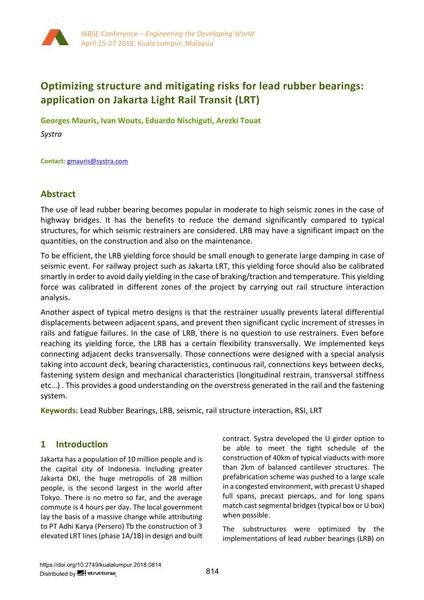Optimizing structure and mitigating risks for lead rubber bearings: application on Jakarta Light Rail Transit (LRT)

|
|
|||||||||||
Détails bibliographiques
| Auteur(s): |
Georges Mauris
(Systra)
Ivan Wouts (Systra) Eduardo Nischiguti (Systra) Arezki Touat (Systra) |
||||
|---|---|---|---|---|---|
| Médium: | papier de conférence | ||||
| Langue(s): | anglais | ||||
| Conférence: | IABSE Conference: Engineering the Developing World, Kuala Lumpur, Malaysia, 25-27 April 2018 | ||||
| Publié dans: | IABSE Conference Kuala Lumpur 2018 | ||||
|
|||||
| Page(s): | 814-819 | ||||
| Nombre total de pages (du PDF): | 6 | ||||
| DOI: | 10.2749/kualalumpur.2018.0814 | ||||
| Abstrait: |
The use of lead rubber bearing becomes popular in moderate to high seismic zones in the case of highway bridges. It has the benefits to reduce the demand significantly compared to typical structures, for which seismic restrainers are considered. LRB may have a significant impact on the quantities, on the construction and also on the maintenance. To be efficient, the LRB yielding force should be small enough to generate large damping in case of seismic event. For railway project such as Jakarta LRT, this yielding force should also be calibrated smartly in order to avoid daily yielding in the case of braking/traction and temperature. This yielding force was calibrated in different zones of the project by carrying out rail structure interaction analysis. Another aspect of typical metro designs is that the restrainer usually prevents lateral differential displacements between adjacent spans, and prevent then significant cyclic increment of stresses in rails and fatigue failures. In the case of LRB, there is no question to use restrainers. Even before reaching its yielding force, the LRB has a certain flexibility transversally. We implemented keys connecting adjacent decks transversally. Those connections were designed with a special analysis taking into account deck, bearing characteristics, continuous rail, connections keys between decks, fastening system design and mechanical characteristics (longitudinal restrain, transversal stiffness etc…) . This provides a good understanding on the overstress generated in the rail and the fastening system. |
||||
